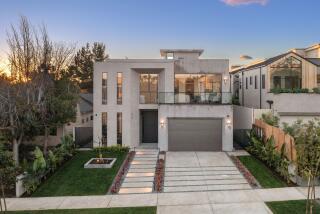Luxuries of past are now standard
WASHINGTON — To understand how much the typical American home has changed in 60 years, just look in the bathroom. It’s hard to find one that doesn’t have hot water, a toilet and a bathtub.
In 1940, barely half of U.S. homes had all three features.
Likewise, a telephone was a luxury item for many Americans when World War II began. Now they’re ubiquitous, with some families placing them in every room, including the bathroom.
And it’s not just what’s in the home that’s changed.
The size of new homes increased by more than 50% between 1970 and 2000. Formal living rooms have been replaced by more livable family rooms and dens, kitchens have expanded to include eating areas, and bathrooms have proliferated.
“Americans put homeownership on a pedestal,” said Howard Decker, chief curator of the National Building Museum in Washington. “When you understand how central the single-family home is to the American dream and American mythology, you can understand why a bigger version of the home is better.”
Since 1940 the Census Bureau has collected detailed data on how Americans live. Although some results from the 2000 census still are being tabulated, the figures released show dramatic changes in the evolution of the American home.
In 1940, only 55% of homes with plumbing had what the government considers a “complete system”: hot and cold running water, a flush toilet and a tub or shower. Sixty years later, 99% of homes had all those features.
James “Ding” Brannan, 69, grew up in a home that used a coal-burning stove for heat. He shared an outhouse with his three siblings and had no regular access to indoor plumbing until he was 17 and joined the Navy. His parents added a bathroom while he was overseas.
“My first reaction when I heard was ‘Good, finally, it’s about time,’ ” said Brannan, a retired government worker whose home in Bowie, Md., has two bathrooms. “I didn’t want to have to go back there with an outhouse after getting used to a bathroom in the Navy.”
The Census Bureau has altered questions to reflect changes in how people live. For instance, the government once asked if a family had access to a phone, either inside the house or outside, such as one shared with neighbors. As recently as 1960, just over 1 in 5 homes did not have access.
The 2000 census only asked whether a family had a phone in the home. Only 1 in 50 did not.
In the future, more homes will come with built-in Internet connections and multimedia systems, said Ross Heitzmann, director of business development for the National Assn. of Home Builders Research Center.
“Each generation’s luxury is the next generation’s standard,” said Robert Lang, a demographer for the Metropolitan Institute at Virginia Tech in Alexandria, Va.
American homes also are spreading out. More than half of new homes in 2000 had two or more floors, compared with fewer than one-fifth in 1971. The percentage of new homes built with four or more bedrooms grew from 24% to 34% over roughly the same period, even though Americans generally are having fewer children.
Lang said homeowners often convert extra bedrooms to home offices or entertainment centers, examples of what he calls “the genius Americans have in finding new uses for a room.”
The emergence of suburbs during the mid-20th century helped spur the proliferation of larger homes. People who left cramped quarters in cities desired space, inside and outside.
The average size of a new single-family home increased from 1,500 square feet to more than 2,200 square feet between 1970 and 2000. The percentage of new homes built with at least 2 1/2 bathrooms rose from 15% to 54% during the same time.
“I don’t see how homes can get any bigger,” said Ray Hine, 74, a retired home builder from Winston-Salem, N.C. “I’m just glad I got out of the business, because I would be scared getting on the roof of these new houses.”
*
(BEGIN TEXT OF INFOBOX)
Measuring up
The average size of a home built today is 50% larger than one built 30 years ago. More than half of U.S. homes have at least two baths.
Size of single-family home (in square feet)
1970 -- 1,500
2000 -- 2,266
Homes with 2.5 or more bathrooms
1970 -- 15%
2000 -- 54%
Homes with no phone service
1960 -- 21.5%
2000 -- 2.4%
*
Source: U.S. Census Bureau, Associated Press

